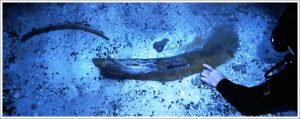Mississippian Symbolism at the Ortona Archaeological Site
Archaeologists working at the Ortona site in the late 1990s and early 2000s were astounded to find “landscaping” in the shape of the scepters carried by the Maya elite in the Yucatan Peninsula. Both a mound and a ceremonial pond were over 100 yards/meters long. The discovery has great significance for the understanding of how cultural ideas traveled around the Caribbean Basin and North America, prior to the arrival of European explorers.



